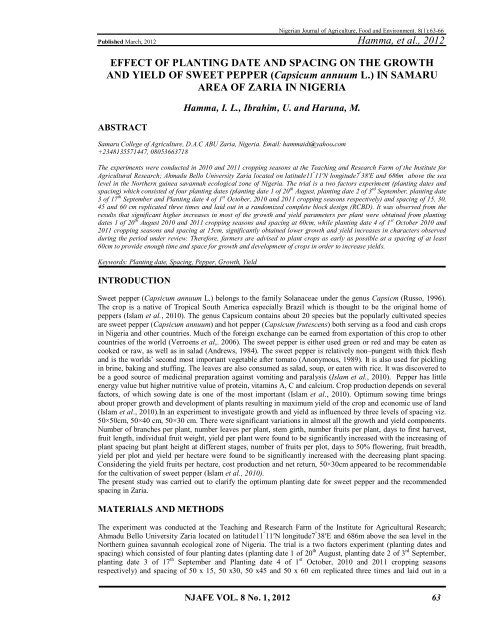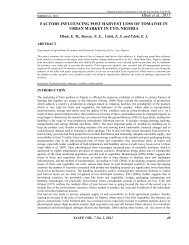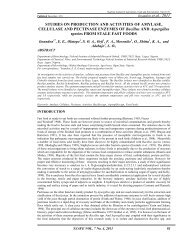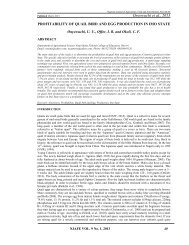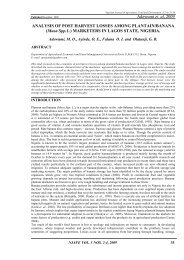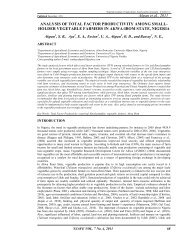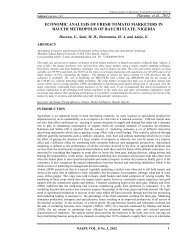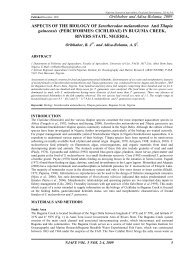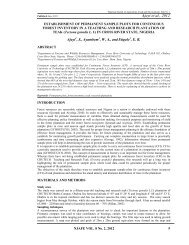Hamma, et al., 2012 EFFECT OF PLANTING DATE AND ... - Njafe.org
Hamma, et al., 2012 EFFECT OF PLANTING DATE AND ... - Njafe.org
Hamma, et al., 2012 EFFECT OF PLANTING DATE AND ... - Njafe.org
You also want an ePaper? Increase the reach of your titles
YUMPU automatically turns print PDFs into web optimized ePapers that Google loves.
Nigerian Journ<strong>al</strong> of Agriculture, Food and Environment. 8(1):63-66<br />
Published March, <strong>2012</strong> <strong>Hamma</strong>, <strong>et</strong> <strong>al</strong>., <strong>2012</strong><br />
<strong>EFFECT</strong> <strong>OF</strong> <strong>PLANTING</strong> <strong>DATE</strong> <strong>AND</strong> SPACING ON THE GROWTH<br />
<strong>AND</strong> YIELD <strong>OF</strong> SWEET PEPPER (Capsicum annuum L.) IN SAMARU<br />
AREA <strong>OF</strong> ZARIA IN NIGERIA<br />
ABSTRACT<br />
<strong>Hamma</strong>, I. L., Ibrahim, U. and Haruna, M.<br />
Samaru College of Agriculture, D.A.C ABU Zaria, Nigeria. Email: hammaidi@yahoo.com<br />
+2348135571447, 08053663718<br />
The experiments were conducted in 2010 and 2011 cropping seasons at the Teaching and Research Farm of the Institute for<br />
Agricultur<strong>al</strong> Research; Ahmadu Bello University Zaria located on latitude11 ° 11′N longitude7 ° 38′E and 686m above the sea<br />
level in the Northern guinea savannah ecologic<strong>al</strong> zone of Nigeria. The tri<strong>al</strong> is a two factors experiment (planting dates and<br />
spacing) which consisted of four planting dates (planting date 1 of 20 th August, planting date 2 of 3 rd September, planting date<br />
3 of 17 th September and Planting date 4 of 1 st October, 2010 and 2011 cropping seasons respectively) and spacing of 15, 30,<br />
45 and 60 cm replicated three times and laid out in a randomized compl<strong>et</strong>e block design (RCBD). It was observed from the<br />
results that significant higher increases in most of the growth and yield param<strong>et</strong>ers per plant were obtained from planting<br />
dates 1 of 20 th August 2010 and 2011 cropping seasons and spacing at 60cm, while planting date 4 of 1 st October 2010 and<br />
2011 cropping seasons and spacing at 15cm, significantly obtained lower growth and yield increases in characters observed<br />
during the period under review. Therefore, farmers are advised to plant crops as early as possible at a spacing of at least<br />
60cm to provide enough time and space for growth and development of crops in order to increase yields.<br />
Keywords: Planting date, Spacing, Pepper, Growth, Yield<br />
INTRODUCTION<br />
Swe<strong>et</strong> pepper (Capsicum annuum L.) belongs to the family Solanaceae under the genus Capsicm (Russo, 1996).<br />
The crop is a native of Tropic<strong>al</strong> South America especi<strong>al</strong>ly Brazil which is thought to be the origin<strong>al</strong> home of<br />
peppers (Islam <strong>et</strong> <strong>al</strong>., 2010). The genus Capsicum contains about 20 species but the popularly cultivated species<br />
are swe<strong>et</strong> pepper (Capsicum annuum) and hot pepper (Capsicum frutescens) both serving as a food and cash crops<br />
in Nigeria and other countries. Much of the foreign exchange can be earned from exportation of this crop to other<br />
countries of the world (Verroens <strong>et</strong> <strong>al</strong>,. 2006). The swe<strong>et</strong> pepper is either used green or red and may be eaten as<br />
cooked or raw, as well as in s<strong>al</strong>ad (Andrews, 1984). The swe<strong>et</strong> pepper is relatively non–pungent with thick flesh<br />
and is the worlds’ second most important veg<strong>et</strong>able after tomato (Anonymous, 1989). It is <strong>al</strong>so used for pickling<br />
in brine, baking and stuffing. The leaves are <strong>al</strong>so consumed as s<strong>al</strong>ad, soup, or eaten with rice. It was discovered to<br />
be a good source of medicin<strong>al</strong> preparation against vomiting and par<strong>al</strong>ysis (Islam <strong>et</strong> <strong>al</strong>., 2010). Pepper has little<br />
energy v<strong>al</strong>ue but higher nutritive v<strong>al</strong>ue of protein, vitamins A, C and c<strong>al</strong>cium. Crop production depends on sever<strong>al</strong><br />
factors, of which sowing date is one of the most important (Islam <strong>et</strong> <strong>al</strong>., 2010). Optimum sowing time brings<br />
about proper growth and development of plants resulting in maximum yield of the crop and economic use of land<br />
(Islam <strong>et</strong> <strong>al</strong>., 2010).In an experiment to investigate growth and yield as influenced by three levels of spacing viz.<br />
50×50cm, 50×40 cm, 50×30 cm. There were significant variations in <strong>al</strong>most <strong>al</strong>l the growth and yield components.<br />
Number of branches per plant, number leaves per plant, stem girth, number fruits per plant, days to first harvest,<br />
fruit length, individu<strong>al</strong> fruit weight, yield per plant were found to be significantly increased with the increasing of<br />
plant spacing but plant height at different stages, number of fruits per plot, days to 50% flowering, fruit breadth,<br />
yield per plot and yield per hectare were found to be significantly increased with the decreasing plant spacing.<br />
Considering the yield fruits per hectare, cost production and n<strong>et</strong> r<strong>et</strong>urn, 50×30cm appeared to be recommendable<br />
for the cultivation of swe<strong>et</strong> pepper (Islam <strong>et</strong> <strong>al</strong>., 2010).<br />
The present study was carried out to clarify the optimum planting date for swe<strong>et</strong> pepper and the recommended<br />
spacing in Zaria.<br />
MATERIALS <strong>AND</strong> METHODS<br />
The experiment was conducted at the Teaching and Research Farm of the Institute for Agricultur<strong>al</strong> Research;<br />
Ahmadu Bello University Zaria located on latitude11 ° 11′N longitude7 ° 38′E and 686m above the sea level in the<br />
Northern guinea savannah ecologic<strong>al</strong> zone of Nigeria. The tri<strong>al</strong> is a two factors experiment (planting dates and<br />
spacing) which consisted of four planting dates (planting date 1 of 20 th August, planting date 2 of 3 rd September,<br />
planting date 3 of 17 th September and Planting date 4 of 1 st October, 2010 and 2011 cropping seasons<br />
respectively) and spacing of 50 x 15, 50 x30, 50 x45 and 50 x 60 cm replicated three times and laid out in a<br />
NJAFE VOL. 8 No. 1, <strong>2012</strong> 63
Nigerian Journ<strong>al</strong> of Agriculture, Food and Environment. 8(1):63-66<br />
Published March, <strong>2012</strong> <strong>Hamma</strong>, <strong>et</strong> <strong>al</strong>., <strong>2012</strong><br />
randomized compl<strong>et</strong>e block design (RCBD). The Seedlings of swe<strong>et</strong> pepper loc<strong>al</strong> cultivar c<strong>al</strong>led ‘Tattase’ were<br />
kept in the nursery for one month before transplanting for each of the treatments. The seedlings were transplanted<br />
in plots that measured 5 x 3m at the rate indicated in the experiment. Each plot contained 30 seedlings, the tot<strong>al</strong><br />
number of seedlings were 30 x 12 plots (i.e. tot<strong>al</strong> of 360 seedlings). The tot<strong>al</strong> plot size of the experiment<strong>al</strong> area<br />
was 180 m 2 . After transplanting seedlings from the nursery to the field, the following operations were carried out<br />
to promote their early establishment, quick growth and development. The crop was irrigated as required<br />
depending on the moisture status of the soil and requirement of plants. Plots with transplanted seedlings were<br />
regularly observed to identify damaged or dead seedlings for replacement. Weeding was done as required and <strong>al</strong>so<br />
plant protection measures were carried out against insects and diseases through appropriate application of<br />
pesticides.<br />
Data collection<br />
Data was collected from five randomly selected plants in each plot on growth and yield characters such as plant<br />
height (cm), number of leaves per plant, number of branches per plant, stem girth (mm), fruit length (cm), fruit<br />
breadth (cm), days to 50% flowering, number of fruits per plant, yield per plot (kg) and yield per ha (kg). Data<br />
was statistic<strong>al</strong>ly an<strong>al</strong>ysed using GENSTAT. The an<strong>al</strong>ysis of variance (ANOVA) was performed to find out the<br />
significance of variation among the treatments while the significance difference b<strong>et</strong>ween mean treatments were<br />
separated using the Duncan’s’ Multiple Range Test (DMRT) at 5% level of probability.<br />
RESULTS<br />
All growth characters showed significant variations due to planting dates and spacing as shown in (Table 1).<br />
Treatment 1, planting date of 20 th August 2010 and 2011, spacing at 60cm and interactions b<strong>et</strong>ween planting dates<br />
and spacing significantly produced higher mean v<strong>al</strong>ues on plant height (cm), number of leaves per plant, number<br />
of branches per plant and stem girth (mm) per plant, number of fruits per plant, fruit yield per plant and fruit yield<br />
per hectare in <strong>al</strong>l the stages of assessment. However, planting date of 1 st October 2010 and 2011 cropping seasons,<br />
spacing at 15cm and interactions b<strong>et</strong>ween planting dates and spacing significantly produced lower mean v<strong>al</strong>ues on<br />
<strong>al</strong>l growth characters at <strong>al</strong>l stages of measurement. The yield characters such as fruits per plant and fruit yield per<br />
hectare were significantly different due to planting date and spacing. Planting date 1 of 20 th August 2010 and<br />
2011 cropping seasons, spacing at 60cm and interactions b<strong>et</strong>ween planting dates and spacing significantly<br />
produced higher mean v<strong>al</strong>ues among the treatments, while planting date 4 of 1 st October 2010 and 2011 cropping<br />
seasons; spacing at 15cm and interactions b<strong>et</strong>ween planting dates and spacing significantly produced lower mean<br />
v<strong>al</strong>ues on yield param<strong>et</strong>ers recorded. Fruit lengths per plant and fruit girth per plant were not significantly<br />
different. However, there were no significant interactions on these characters.<br />
DISCUSSION<br />
The observations of significant variations among the treatments indicated that cultivation of any crop depends on<br />
sever<strong>al</strong> factors for growth and development. Planting dates and spacing has been observed as some of the factors<br />
that affect growth and development of a crop. Islam <strong>et</strong> <strong>al</strong>. (2010) reported that optimum sowing dates and spacing<br />
of a crop ensures proper growth, development and maximises the yield of the crop. Also optimum planting dates<br />
and spacing ensures the economy of land use of a crop. As observed from the results of this tri<strong>al</strong>, planting dates 1<br />
and 60cm spacing performed b<strong>et</strong>ter in terms of growth and yield characters than the rest of the treatments by<br />
giving higher v<strong>al</strong>ues. Progression further into drier period and spacing significantly decreased the v<strong>al</strong>ues of<br />
param<strong>et</strong>ers measured on the crop. From planting dates of 20 th August 2010 and 2011 cropping seasons; spacing at<br />
60cm down to planting dates 4 of 1 st October 2010 and 2011 cropping seasons; spacing at 15cm, treatment means<br />
decreased accordingly. This means that the earlier and proper you space a crop the b<strong>et</strong>ter the performances of the<br />
crop with respect to growth and yield characters. Planting dates 4 of 1 st October 2010 and 2011 cropping seasons;<br />
as well as spacing at 15cm could not produce higher mean v<strong>al</strong>ues because the duration and space of the crop was<br />
not quite enough to guarantee plants under this treatment compl<strong>et</strong>e the veg<strong>et</strong>ative and reproductive phases fully.<br />
Also, comp<strong>et</strong>ition for resources by plants under this treatment was higher resulting into haste by plants under this<br />
treatment to compl<strong>et</strong>e their growth and development<strong>al</strong> stages.<br />
CONCLUSION<br />
It was observed from the results that significant higher increases in most of the growth and yield param<strong>et</strong>ers per<br />
plant were obtained from planting dates 1 of 20 th August 2010 and 2011 cropping seasons and spacing at 60cm,<br />
while planting date 4 of 1 st October 2010 and 2011 cropping seasons and spacing at 15cm, significantly obtained<br />
lower growth and yield in characters observed during the period under review. Therefore, farmers are advised to<br />
NJAFE VOL. 8 No. 1, <strong>2012</strong> 64
Nigerian Journ<strong>al</strong> of Agriculture, Food and Environment. 8(1):63-66<br />
Published March, <strong>2012</strong> <strong>Hamma</strong>, <strong>et</strong> <strong>al</strong>., <strong>2012</strong><br />
plant crops as early as possible at a spacing of at least 60cm to provide enough time and space for growth and<br />
development of crops in order to increase yields.<br />
REFERENCES<br />
Andrews, J. 1984. Pepper The Domesticated Capsicum. University of Texas Press, Austin. P321.<br />
Anonymous, 1989. Tomato and Pepper Production in the Tropics. Asian Veg<strong>et</strong>able Research and Development<br />
Centre, Taiwan. P585.<br />
Bevacqua, R. F. Vanleeuween, D. M. 2003. Planting date effects on stand establishment and yield of chilli pepper.<br />
American Soci<strong>et</strong>y for Horticultur<strong>al</strong> Science. 38: 357 – 365.<br />
Islam, M. Saha, S. Akand, H. Rahim, A. 2010. Efffect of sowing date on the growth and yield of swe<strong>et</strong> pepper<br />
(Capsicum annuum L.) Agronomski Glasnik 1/2010.<br />
Russo, V. M. 1996. Planting date, fertilizer rate and harvest time affect yield of J<strong>al</strong>apeno and Banana peppers.<br />
American Soci<strong>et</strong>y for Horticultur<strong>al</strong> Science, 31(7): 107 – 1118.<br />
Verroens, P. Verlinden, B. E. Sauviller, C. Lammertyn, J. De K<strong>et</strong>elaere, B. Nicolai, B. M. 2006. Time series<br />
an<strong>al</strong>ysis of Capsicum annuum fruit production cultivated in greenhouse. ISHS Acta Horticulture 718: III<br />
Internation<strong>al</strong> Symposium on Models for plant growth, Environment<strong>al</strong> control and farm management in<br />
protected cultivation.<br />
NJAFE VOL. 8 No. 1, <strong>2012</strong> 65
Nigerian Journ<strong>al</strong> of Agriculture, Food and Environment. 8(1):63-66<br />
Published March, <strong>2012</strong> <strong>Hamma</strong>, <strong>et</strong> <strong>al</strong>., <strong>2012</strong><br />
Table 1: Growth and yield of pepper as influenced by planting dates and spacing at Samaru, Zaria in 2010 and 2011 cropping seasons<br />
Treatments Plant height<br />
(cm)<br />
Planting dates<br />
4<br />
3<br />
2<br />
1<br />
Spacing (cm)<br />
15<br />
30<br />
45<br />
60<br />
2010 2011<br />
14.60d 15.33d<br />
17.72c 18.45c<br />
20.46b 21.71b<br />
24.04a 25.64a<br />
13.67d 13.45d<br />
15.68c 15.34c<br />
18.11b 20.57b<br />
23.12a 24.36a<br />
Number of leaves<br />
per plant<br />
2010 2011<br />
51.62d 57.48d<br />
59.48c 60.82c<br />
68.31b 69.71b<br />
87.42a 84.91a<br />
48.24d 54.86d<br />
54.46c 58.78c<br />
64.24b 65.15b<br />
83.27a 84.78a<br />
Number of<br />
branches per<br />
plant<br />
2010 2011<br />
8.22d 9.24d<br />
9.32c 10.60c<br />
10.49b 11.63b<br />
15.88a 16.72a<br />
7.42d 11.26d<br />
8.11cd 11.44c<br />
11.24b 13.22b<br />
13.27a 15.32a<br />
Stem<br />
(mm)<br />
girth<br />
5.45c 5.29b<br />
6.35bc 6.43bc<br />
8.21a 8.31a<br />
10.25a 10.46a<br />
4.24d 8.42d<br />
5.14cd 10.11c<br />
7.08b 11.21b<br />
9.47a 13.15a<br />
Number of fruits<br />
per plant<br />
2010 2011<br />
6.05c 7.92bc<br />
8.41b 9.22b<br />
11.25b 11.43b<br />
14.28a 15.41a<br />
5.24c 5.32c<br />
6.43bc 6.52bc<br />
9.12b 9.40b<br />
11.23a 12.08a<br />
Fruit length<br />
per plant<br />
(cm)<br />
3.13a 3.15a<br />
3.22a 3.24a<br />
3.32a 3.35a<br />
3.44a 3.48a<br />
3.10a 3.12a<br />
3.14a 3.16a<br />
3.24a 3.27a<br />
3.38a 3.42a<br />
Fruit<br />
per<br />
(cm)<br />
girth<br />
plant<br />
1.01a 1.09a<br />
1.15a 1.11a<br />
1.31a 1.14a<br />
1.42a 1.44a<br />
1.11a 1.13a<br />
1.15a 1.16a<br />
1.24a 1.25a<br />
1.45a 1.50a<br />
Fruit yield per<br />
plant (kg)<br />
2010 2011<br />
2.24b 2.25b<br />
2.89b 2.92b<br />
.98ab2.99ab<br />
3.11a 3.13a<br />
2.18b 2.20b<br />
2.32ab 2.33ab<br />
3.14a 3.16a<br />
3.35a 3.40a<br />
Fruit yield per<br />
hectare (kg)<br />
2010 2011<br />
1,734.15d 1821.21d<br />
1,947.26c 1954.32c<br />
2,894.41b 2924.11b<br />
3,872.56a 3946.28a<br />
1532.27c 1723.24d<br />
178934bc 1843.27bc<br />
276843b 2864.27b<br />
364328a 3743.26a<br />
Interactions<br />
P x S * * * * * NS NS * *<br />
Means with the same l<strong>et</strong>ter (s) within a column are not significantly different at P = 0.05 using Duncan’s Multiple Range Test (DMRT).<br />
1 = 20 th August, 2010 and 2011 2 = 3 rd September, 2010 and 2011 3 = 17 th September, 2010 and 2011 4 = 1 st October, 2010 and 2011<br />
NS = Not significant at 5% level of significance<br />
* = Significant<br />
NJAFE VOL. 8 No. 1, <strong>2012</strong> 66


